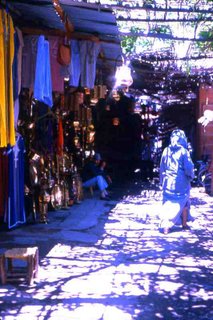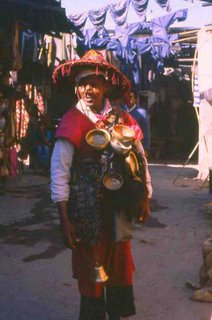


It translates roughly to “Place of the Dead,” but Marrakech’s Djema el Fna, an amphitheater-shaped public space in the city’s old walled heart, is alive with a bizarre and raucous cast of characters and their props.
Fortune tellers; story spinners; henna artists; acrobats; beggars; nut vendors; bell-ringing water sellers wearing bandoliers of brass drinking cups; hookah puffers; dancers; healers; showmen with monkeys on ropes; snake charmers; cigarette boys; cooks offering moist clumps of couscous or spicy lamb tagine from clay pots topped with tall, conical lids.
And touts, louts, and legions of young men shouting, “Guide, lady? Guide, lady?”
Their persistence – angry and unkind rather than reassuring and welcoming – caused me to pop my cork, something I rarely do when a guest in someone else’s land. There are tourist police to help keep the badgerers at bay, but independent travel to Morocco’s cities requires some stomach for being pestered, and my stomach had had its fill. There, in the middle of Marrakech’s daily public circus, I began waving off every young man who came near me with a preemptory “NO GUIDE!” I showed my teeth and shook my arms.
My distress amused one snake charmer who slithered over and stuck his serpent in my face. Had my heart been but a tad weaker, I would have died right there in the Place of the Dead. I screamed, the faux-guides laughed, and the ghoulish charmer tried to wrap his reptile around my shoulders.
To find some peace, I escaped into the place that all my reading had warned against entering without a reputable guide: the souk.
Just beyond the Djema el Fna lies an enclosed, labyrinthine world of tiny wooden shops filled with amazing things: gloriously-colored carpets; vessels wrought from brilliant brass; satchels and slippers of soft, hand-tooled leather; exotic herbs, remedies, lotions and potions; jewelry set with polished gems from the Ourika Valley or Atlas Mountains.
Along thin lanes splashed here and there with patches of penetrating sunlight, I looked on homes with colorful doorways and half-hidden courtyards; places of learning and worship resting behind graceful arched entrances; quiet teahouses; potted palms; lightbulbs that glowed melon and amber; thick skeins of new wool, just dyed cinnamon or indigo and strung in rows above the alleys to dry; green arbors; trellises bursting with red and orange blooms.
Near the souk’s entrance, touts targeting tourists hung like locust. But once I was clear of them and headed deeper into this ancient marketplace world, no one bothered me. Shopkeepers beckoned only gently, pointing to their goods on offer and settling back into the shade when I nodded and passed them by. Children played in alleys. Families took tea.
As I made my way through the maze, looking for an exit, I got lost. Good lost. The kind of relaxed lost you know you’ll find your way out of and that delivers wonder as you make your way through it. I finally saw full sunlight through a break in the walls and headed toward it, hoping for a door out of the souk-world.
I stepped through an arched gate into the bright light of the tannery quarter. Crouched, barefoot men in shorts were beating cow, goat and camel skins under the unforgiving African sun and bathing the emerging leather in vats filled with pungent softening agents and dyes, some chemical, some natural. Berries and bark, saffron and seeds, cattle urine and pigeon guano sat steeping in the heat-pounded stone vats, their individual odors rising and fusing into one fantastic Marrakech stink.
I stood breathing the smell and absorbing the scene. And no one bothered me.
www.LoriHein.com
